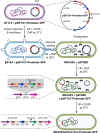Modified Tn 7 transposon vectors for controlled chromosomal gene expression
- PMID: 39291982
- PMCID: PMC11497813
- DOI: 10.1128/aem.01556-24
Modified Tn 7 transposon vectors for controlled chromosomal gene expression
Abstract
Complementation remains a foundation for demonstrating molecular Koch's postulates. While this is frequently achieved using plasmids, limitations such as increased gene copy number and the need for antibiotic supplementation to avoid plasmid loss can restrict their use. Chromosomal integration systems using the Tn7 transposon provide an alternative to plasmids for complementation and facilitate the stable insertion of genes at the chromosomal attTn7 site without the need for selection pressure. Here, we enhanced the utility of mini-Tn7 insertion vectors by the addition of inducible (Pcym) and constitutive (PcL and PrpsM) promoters, allowing differential transcriptional control of genes integrated into the chromosome. We validated the utility of these promoters by cloning the gfp gene, encoding green fluorescent protein, downstream of each promoter and integrating a mini-Tn7 construct harboring these elements into the attTn7 site on the chromosome of the Escherichia coli K-12 strain MG1655. The PcL and PrpsM promoters provided equivalent levels of GFP expression and offered flexibility based on the target host strain. Activation of the tightly regulated Pcym promoter with its inducer cumate resulted in tunable expression of GFP in a dose-dependent manner. We further demonstrated the tight control of the Pcym promoter using the toxic impCAB genes, and the expression of which is detrimental to E. coli viability. Together, these modified mini-Tn7 vectors allowing differential control of genes integrated into the chromosome at a conserved site offer an efficient system for complementation where plasmid use is restricted.IMPORTANCEChromosomal integration using mini-Tn7 vectors provides an efficient means to insert genes into the chromosome of many gram-negative bacteria. Insertion occurs at a conserved site and allows for the stable integration of genes in single copy. While this system has multiple benefits for enabling complementation, a cornerstone for fulfilling molecular Koch's postulates, greater flexibility for controlled gene expression would enhance its utility. Here, we have added to the function of mini-Tn7 vectors by the addition of inducible and constitutive promoters and demonstrated their capacity to drive the controlled expression of target genes integrated into the chromosome. In addition to complementation, these modified vectors offer broad application for other approaches including chromosomal tagging, in vivo expression, metabolic engineering, and synthetic biology.
Keywords: Tn7; gene expression; transcriptional regulation; transposon.
Conflict of interest statement
The authors declare no conflict of interest.
Figures




Similar articles
-
mini-Tn7 insertion in bacteria with secondary, non-glmS-linked attTn7 sites: example Proteus mirabilis HI4320.Nat Protoc. 2006;1(1):170-8. doi: 10.1038/nprot.2006.26. Nat Protoc. 2006. PMID: 17406229
-
Tn5/7-lux: a versatile tool for the identification and capture of promoters in gram-negative bacteria.BMC Microbiol. 2015 Feb 4;15(1):17. doi: 10.1186/s12866-015-0354-3. BMC Microbiol. 2015. PMID: 25648327 Free PMC article.
-
Next Generation of Tn7-Based Single-Copy Insertion Elements for Use in Multi- and Pan-Drug-Resistant Strains of Acinetobacter baumannii.Appl Environ Microbiol. 2019 May 16;85(11):e00066-19. doi: 10.1128/AEM.00066-19. Print 2019 Jun 1. Appl Environ Microbiol. 2019. PMID: 30902859 Free PMC article.
-
Tn7: a target site-specific transposon.Mol Microbiol. 1991 Nov;5(11):2569-73. doi: 10.1111/j.1365-2958.1991.tb01964.x. Mol Microbiol. 1991. PMID: 1664019 Review.
-
Tn7 elements: engendering diversity from chromosomes to episomes.Plasmid. 2009 Jan;61(1):1-14. doi: 10.1016/j.plasmid.2008.09.008. Epub 2008 Nov 1. Plasmid. 2009. PMID: 18951916 Free PMC article. Review.
Cited by
-
Generation and validation of a versatile inducible multiplex CRISPRi system to examine bacterial regulation in the Euprymna-Vibrio fischeri symbiosis.Arch Microbiol. 2025 May 17;207(7):147. doi: 10.1007/s00203-025-04354-8. Arch Microbiol. 2025. PMID: 40380978 Free PMC article.
References
-
- Ensley BD. 1986. Stability of recombinant plasmids in industrial microorganisms. Crit Rev Biotechnol 4:263–277. doi:10.3109/07388558609150796 - DOI
MeSH terms
Substances
Grants and funding
LinkOut - more resources
Full Text Sources
Research Materials

